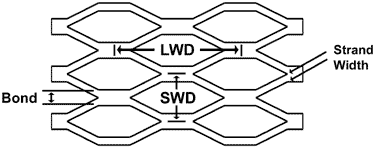
Expanded Metals Terminology
Expanded Metal: A rigid piece of metal that has been slit and drawn into an open mesh pattern in a single operation. It is stronger, lighter in weight and more rigid than the original base metal. Conventional mesh is formed in a diamond pattern.
Base Metal: Original metal before it is expanded; thickness is usually stated as gauge.
Finished Thickness: Thickness of expanded metal after it’s final secondary operation(s).
Strand: One side of expanded metal design. (See Diagram)
Bond: The solid intersection of two strands - Double the strand width. (See Diagram)
SWD: Short way of design measured from center of bond to center of bond. (See Diagram)
LWD: Long way of design measured from center of bond to center of bond. (See diagram)
Flattened: Expanded metal that has been cold-rolled after expansion, to provide a smooth, flat, and level sheet. The flattening process usually reduces the original gauge of the base metal.
Unflattened: Expanded metal as it is produced off the expanded metal press with no secondary flattening operation. Material looks similar to a louvered design.
Coil Expanded metal that is produced to a specific width and then wound on a core. Typical footage per coil is 2,000 or more feet.
Cut to length (sheet) Expanded metal that is produced to a specific width and length.
- SWD: "Short Way of the Diamond", the distance from the middle of the bond on one side to the middle of the bond on the opposite side.
- LWD: "Long Way of the Diamond", the distance across the largest dimension of the diamond measured halfway between the diamonds.
- SWO: “Short Way of the Opening",the width of the opening of the shortest side of the diamond.
- LWO:"Long Way of the Opening",the length of the opening of the longest side of the diamond.
No.33, Lingyuan Street, Anping, China Url:https://www.expanded-metal.org
